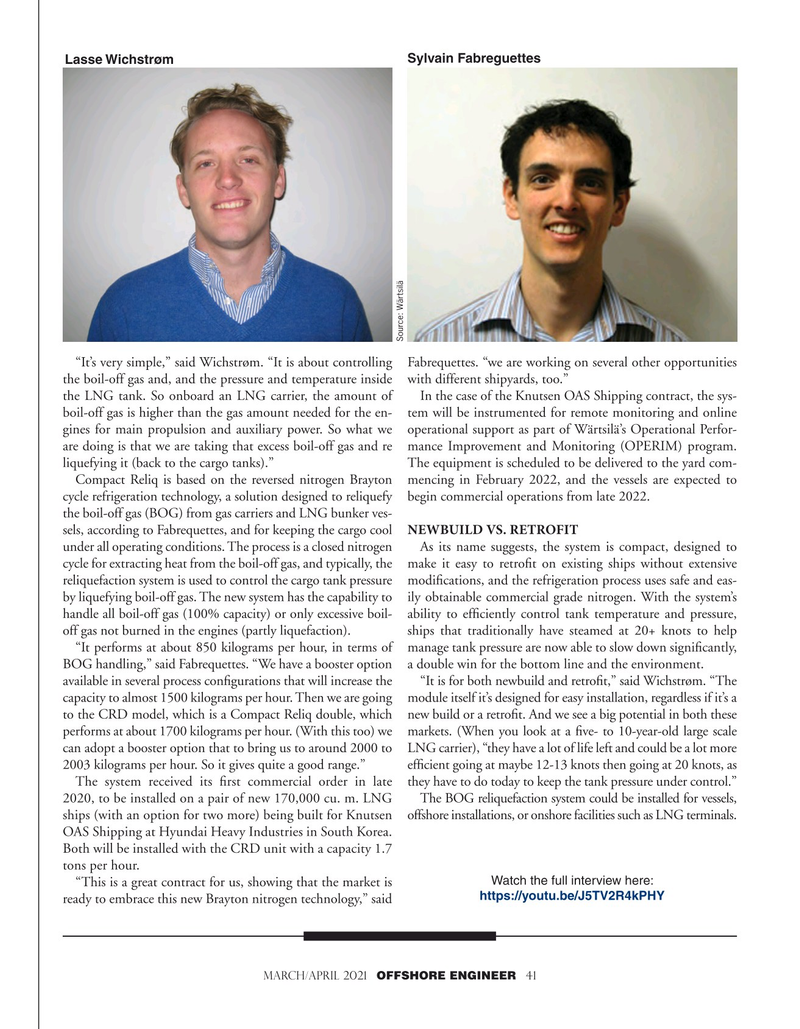
Page 41: of Offshore Engineer Magazine (Mar/Apr 2021)
Offshore Wind Outlook
Read this page in Pdf, Flash or Html5 edition of Mar/Apr 2021 Offshore Engineer Magazine
Lasse Wichstrøm Sylvain Fabreguettes
Source: Wärtsilä “It’s very simple,” said Wichstrøm. “It is about controlling Fabrequettes. “we are working on several other opportunities the boil-off gas and, and the pressure and temperature inside with different shipyards, too.” the LNG tank. So onboard an LNG carrier, the amount of In the case of the Knutsen OAS Shipping contract, the sys- boil-off gas is higher than the gas amount needed for the en- tem will be instrumented for remote monitoring and online gines for main propulsion and auxiliary power. So what we operational support as part of Wärtsilä’s Operational Perfor- are doing is that we are taking that excess boil-off gas and re mance Improvement and Monitoring (OPERIM) program. liquefying it (back to the cargo tanks).” The equipment is scheduled to be delivered to the yard com-
Compact Reliq is based on the reversed nitrogen Brayton mencing in February 2022, and the vessels are expected to cycle refrigeration technology, a solution designed to reliquefy begin commercial operations from late 2022. the boil-off gas (BOG) from gas carriers and LNG bunker ves- sels, according to Fabrequettes, and for keeping the cargo cool NEWBUILD VS. RETROFIT under all operating conditions. The process is a closed nitrogen As its name suggests, the system is compact, designed to cycle for extracting heat from the boil-off gas, and typically, the make it easy to retroft on existing ships without extensive reliquefaction system is used to control the cargo tank pressure modifcations, and the refrigeration process uses safe and eas- by liquefying boil-off gas. The new system has the capability to ily obtainable commercial grade nitrogen. With the system’s handle all boil-off gas (100% capacity) or only excessive boil- ability to effciently control tank temperature and pressure, off gas not burned in the engines (partly liquefaction). ships that traditionally have steamed at 20+ knots to help “It performs at about 850 kilograms per hour, in terms of manage tank pressure are now able to slow down signifcantly,
BOG handling,” said Fabrequettes. “We have a booster option a double win for the bottom line and the environment.
available in several process confgurations that will increase the “It is for both newbuild and retroft,” said Wichstrøm. “The capacity to almost 1500 kilograms per hour. Then we are going module itself it’s designed for easy installation, regardless if it’s a to the CRD model, which is a Compact Reliq double, which new build or a retroft. And we see a big potential in both these performs at about 1700 kilograms per hour. (With this too) we markets. (When you look at a fve- to 10-year-old large scale can adopt a booster option that to bring us to around 2000 to LNG carrier), “they have a lot of life left and could be a lot more 2003 kilograms per hour. So it gives quite a good range.” effcient going at maybe 12-13 knots then going at 20 knots, as
The system received its frst commercial order in late they have to do today to keep the tank pressure under control.” 2020, to be installed on a pair of new 170,000 cu. m. LNG The BOG reliquefaction system could be installed for vessels, ships (with an option for two more) being built for Knutsen offshore installations, or onshore facilities such as LNG terminals.
OAS Shipping at Hyundai Heavy Industries in South Korea.
Both will be installed with the CRD unit with a capacity 1.7 tons per hour.
Watch the full interview here: “This is a great contract for us, showing that the market is https://youtu.be/J5TV2R4kPHY ready to embrace this new Brayton nitrogen technology,” said march/April 2021 OFFSHORE ENGINEER 41

 40
40

 42
42